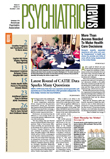Intelligence and teacher ratings of a child's externalizing behaviors appear to be associated with risk of experiencing trauma and developing posttraumatic stress disorder (PTSD).
That was the finding from a longitudinal study of children who were initially assessed at age 6 and followed again at age 17. The report appeared in the November Archives of General Psychiatry.
Youth who received teacher ratings of externalizing problems above the normal range on the Teacher Report Form at age 6 were at increased risk for witnessing or being a victim of violence. (The Teacher Report Form yields scores on two composite scales, externalizing and internalizing; externalizing behaviors include delinquency and aggression, while internalizing refers to being withdrawn, experiencing somatic complaints, and feeling anxious or depressed. Among a list of more than 50 behaviors listed as externalizing are cruelty, bullying, or meanness to others; destroying property belonging to others; physically attacking people; or explosive and unpredictable behavior.)
The risk for PTSD was increased for youth with anxiety disorders and teacher ratings of externalizing problems above the normal range at age 6, said lead researcher Naomi Breslau, Ph.D., of the Department of Epidemiology, and colleagues at Michigan State University.
But youth aged 6 with an IQ above 115 had decreased risk for exposure to trauma and witnessing or being a victim of violence, and a decreased risk for PTSD.
In this study, a cohort of newborns born at two socioeconomically disparate hospitals between 1983 and 1985 were randomly selected and assessed at age 6. of 1,095 in the target birth cohort, 823 (75 percent) participated in the study.
A second assessment was conducted from 1995 to 1997, with children in each birth-year cohort assessed as they passed their 11th birthday. From 2000 to 2002, researchers assessed the sample a third time, with children in each birth-year cohort assessed as they passed their 17th birthday; 713 youth (86.6 percent of the initial cohort) were assessed at this point.
The Wechsler Intelligence Scale for Children-Revised was used to measure IQ at age 6. Behavior problems at age 6 were rated by teachers, using the Teacher Report Form.
Exposure to traumatic events and evidence of PTSD were ascertained at age 17 through a computerized version of the National Institute of Mental Health Diagnostic Interview Schedule. The assessment has a list of 14 DSM-IV qualifying events, and for each event type respondents are asked if they have ever experienced something similar. PTSD was diagnosed using algorithms that implement the diagnostic criteria established in DSM-IV.
“The key findings from this prospective study indicate [that] youth who have been rated by their teachers as being above the normal range of externalizing problems at age 6 were at increased risk for exposure to assaultive violence, but not to other trauma types, controlling for other risk factors for exposure,” the authors stated.
“Disruptive behavior and low IQ in childhood interact with social environments in ways that amplify their adverse effects over time,” the researchers said in the report. “Children with behavior problems might drift toward more disruptive and academically less-competent peers. Conversely, children with lower intelligence might decline academically relative to their peers as the school curriculum advances, a process that increases their chances of affiliating with disruptive peers.
“The evidence of developmental processes by which low intelligence enhances disruptive behavior and disruptive behavior leads to gradual intellectual decline underscores the importance of obtaining early measures of these factors, when their separate effects might be more accurately detected,” they said.
